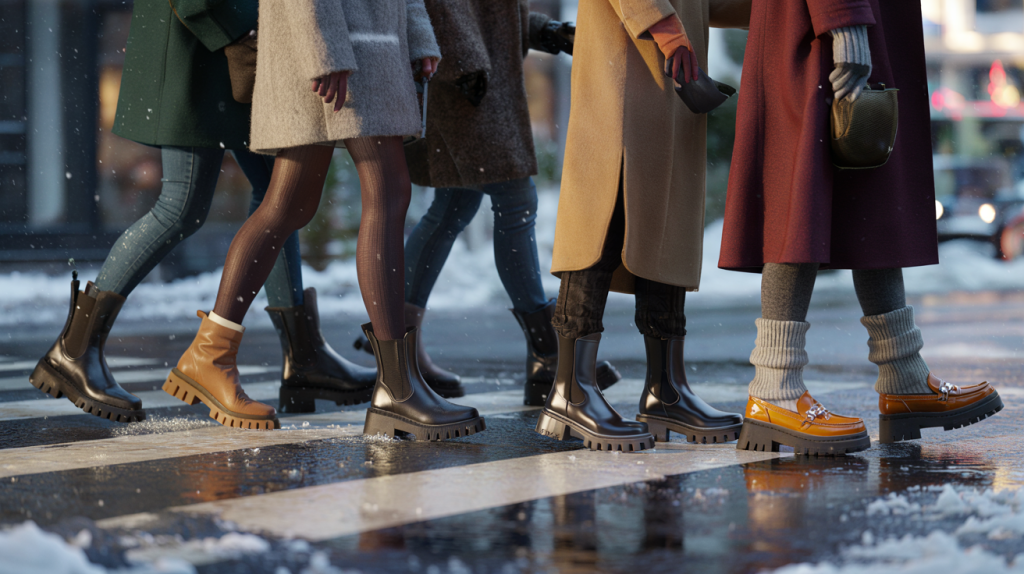Skip cold sneakers. Discover warmer, grippy, outfit-friendly shoes women actually wear all winter, plus the materials and traction details that truly matter.
Cold sidewalks, surprise slush, and dress codes do not always love sneakers. When temperatures drop, women search for warmer, smarter options that still look good with jeans or a midi skirt. Here is the fast answer: go for waterproof leather ankle boots, lug-soled Chelsea styles, insulated hikers, tall boots with traction, or lined clogs and loafers paired with serious socks. Comfort stays, warmth arrives.
The trick is balancing style, warmth, and grip. Prioritize a non-slip outsole, weatherproof uppers, and breathable insulation so feet stay dry on long days. Materials matter: wool blends for moisture control, quality leather for weather resistance, and membranes that block water while letting sweat escape. The result is simple – sneakers can sit out winter without sacrificing your look.
Warm alternatives to sneakers: what actually solves the winter problem
Most winter discomfort starts with moisture and slip risk. Sneakers often soak quickly and their flat outsoles struggle on slick pavements. That is why winter-ready silhouettes with raised treads, protective uppers, and room for socks change the day.
Safety is part of the style brief. The National Safety Council reports 6.9 million people were treated for fall injuries in the U.S. in 2022, a reminder that traction is not just a hiking thing (Source : National Safety Council, 2022, Injury Facts). Pair that with city slush and polished stone floors, and grip goes from nice-to-have to essential.
Breathability prevents the sweaty-chill cycle. Wool can absorb up to 30% of its own weight in moisture without feeling wet, helping regulate foot climate on commutes and in offices (Source : International Wool Textile Organisation, IWTO). For wet days, waterproof-breathable membranes use microscopic pores to vent vapor. Gore states its ePTFE membrane contains about 9 billion pores per square inch, small enough to block liquid water while letting sweat escape (Source : W. L. Gore et al.).
Best women’s winter shoe swaps: stylish picks that stay practical
Here are the reliable categories that replace sneakers without losing everyday ease. Think of them as winter’s rotation, not a one-shoe-fits-all fix.
- Lug-sole Chelsea boots : slip-on ease, ankle coverage, leather uppers that brush off light rain, and chunky rubber for grip.
- Insulated hiking boots : trail tech brought to the city, with padded collars, sealed seams, and deeper treads for icy corners.
- Waterproof leather ankle boots : sleek silhouettes that pass dress codes, often with hidden membranes and warm linings.
- Knee-high or riding boots with traction : wind-blocking shafts, stable block heels, and modern lug outsoles for slick streets.
- Shearling-lined clogs or mules with backstraps : cozy interiors for dry days, paired with ribbed wool socks for warmth.
- Chunky loafers with cold-weather soles : polished upper, winterized outsole, great with opaque tights or socks.
- Insulated rain boots : rubber shells for deep slush, removable liners to dry overnight.
- Hybrid sneaker-boots : sport cushioning plus waterproof uppers and winter tread.
- Apres-inspired mid boots : lightweight, microfleece linings, and compressible comfort on quick errands.
Materials, fit, and real-life comfort: avoid these common mistakes
Choosing only by style and forgetting the outsole. Look for rubber compounds that stay flexible in cold and visible tread patterns that channel water away. Flat, smooth bottoms slide fast.
Confusing water-resistant with waterproof. Water-resistant leather handles brief exposure. Fully waterproof pairs use sealed seams and membranes – helpful in snow, slush, or long wet commutes.
Overlooking sock strategy. Merino-blend socks manage moisture and warmth better than thick cotton, which holds sweat and cools the foot quickly. Thin merino can be warmer than bulky cotton on a long day.
Buying too snug. Winter footwear needs toe wiggle room and space for socks to trap air. If circulation drops, feet feel colder. Insoles with a thin insulating layer can add comfort, and wool insoles truely help in chilly offices.
Skipping care. Quick wipe-downs, leather conditioner, and a spray-on protector extend water resistance and keep salt stains from setting. Less fuss, longer life.
How to build a winter rotation that actually works
Start with traction as non-negotiable, then choose silhouettes to match your routine: one polished pair for work, one rugged pair for bad weather, and one cozy pair for off-duty. That simple trio covers nearly all winter scenarios without defaulting to sneakers every day.
Think in layers, just like outerwear. A waterproof shell plus breathable insulation keeps heat in and sweat out on commutes or errands. On milder days, swap to unlined leather with grippy soles and lean on merino socks for thermal control.
Timing helps too. Search interest for “women’s winter boots” reliably peaks before deep cold sets in, especially in November, according to Google Trends 2024. Stock fluctuates after the first snow, so shopping early widens size and color options.
One last filter: weight versus cushioning. Pick lighter pairs for long walk commutes, and slightly heavier, stiffer soles for icy days. The goal is predictable grip, dry feet, and outfits that feel considered – not compromised.
